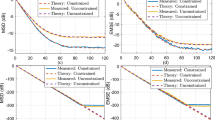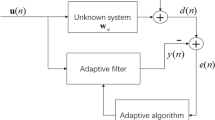Abstract
Two kinds of update equations are commonly used for the constrained frequency-domain adaptive filter (FDAF), namely the gradient-constrained version and the weight-constrained version. The constraint is imposed only on the stochastic gradient vector in the first version, while it is imposed on the whole weight vector in the second version. It was already found that the two versions have different convergence behaviors, but a rigors analysis of the convergence behavior of the gradient-constrained FDAF is still lacking so far. This paper presents a comprehensive statistical analysis of the gradient-constrained FDAF. We set up an equivalent update equation of the gradient-constrained FDAF, which provides a close link with that of the weight-constrained version. Then, the mean and mean-square convergence behaviors of the gradient-constrained FDAF are analyzed using the new update equation, and the corresponding steady-state solutions are provided. Theoretical results confirm that the gradient-constrained FDAF will converge to a biased solution and exhibits a larger mean-square error than the weight-constrained version when, for instance, the weight vector is not initialized properly. Simulation results agree with our theoretical predictions very well.




Similar content being viewed by others
References
J. Benesty, T. Gänsler, A multi-delay double-talk detector combined with the MDF adaptive filter. EURASIP J. Appl. Signal Process. 2003, 1056–1063 (2003)
J.P. Borrallo, M.G. Otero, On the implementation of a partitioned block frequency domain adaptive filter (PBFDAF) for long acoustic echo cancellation. Signal Process. 27(3), 301–315 (1992)
K.S. Chan, B. Farhang-Boroujeny, Analysis of the partitioned frequency-domain block LMS (PFBLMS) algorithm. IEEE Trans. Signal Process. 49(9), 1860–1874 (2001)
G.A. Clark, S.K. Mitra, S.R. Parker, Block implementation of adaptive digital filters. IEEE Trans. Acoust. Speech Signal Process. 29(3), 744–752 (1981)
G.A. Clark, S.R. Parker, S.K. Mitra, A unified approach to time and frequency domain realization of FIR adaptive digital filters. IEEE Trans. Acoust. Speech Signal Process. 31(5), 1073–1083 (1983)
P.S.R. Diniz, Adaptive Filtering: Algorithms and Practical Implementations (Springer, New York, 2013)
G. Enzner, P. Vary, Frequency-domain adaptive Kalman filter for acoustic echo control in hands-free telephones. Signal Process. 86(6), 1140–1156 (2006)
P.G. Estermann, A. Kaelin, A.G. Lindgren, Analysis of partitioned frequency-domain LMS adaptive algorithm with application to a hands-free telephone system echo canceller. Int. J. Adapt. Contr. Signal Process. 14(6), 587–608 (2000)
B. Farhang-Boroujeny, Adaptive Filters: Theory and Applications (John Wiley & Sons, Chichester, West Sussex, United Kingdom, 2013)
B. Farhang-Boroujeny, K.S. Chan, Analysis of the frequency-domain block LMS algorithm. IEEE Trans. Signal Process. 48(8), 2332–2342 (2000)
E.R. Ferrara, Fast implementations of LMS adaptive filters. IEEE Trans. Acoust. Speech Signal Process. 28(4), 474–475 (1980)
A. Feuer, Performance analysis of the block least mean square algorithm. IEEE Trans. Circuits Syst. 32(9), 960–963 (1985)
A. Feuer, R. Cristi, On the steady state performance of frequency domain LMS algorithms. IEEE Trans. Signal Process. 41(1), 419–423 (1993)
J. Franzen, T. Fingscheidt, Improved measurement noise covariance estimation for N-channel feedback cancellation based on the frequency domain adaptive Kalman filter. in Proc. IEEE ICASSP, pp. 965–969 (2019)
C. Hofmann, C. Huemmer, M. Guenther, W. Kellermann, Significance-aware filtering for nonlinear acoustic echo cancellation. EURASIP J. Adv. Signal Process. 2016, 113 (2016)
S. Kuo, D. Morgan, Active Noise Control Systems-Algorithms and DSP Implementations (Wiley, New York, 1996)
J.C. Lee, C.K. Un, Performance analysis of frequency domain block LMS adaptive digital filters. IEEE Trans. Circuits Syst. 36(2), 173–189 (1989)
D. Mansour, A.H. Gray Jr., Performance characteristics of the unconstrained frequency-domain adaptive filter. In: Proceedings of the 1982 IEEE International symposium on circuits and systems, pp. 695–698 (1982)
D. Mansour, A.H. Gray Jr., Unconstrained frequency-domain adaptive filter. IEEE Trans. Acoust. Speech Signal Process. 30(5), 726–734 (1982)
T.K. Moon, W.C. Stirling, Mathematical Methods and Algorithms for Signal Processing (Prentice-Hall, New York, NY, USA, 2000)
T. Padhi, M. Chandra, A. Kar, M. Swamy, A new hybrid active noise control system with convex combination of time and frequency domain filtered-X LMS algorithms. Circuits Syst. Signal Process. 37(8), 3275–3294 (2018)
A.H. Sayed, Fundamentals of Adaptive Filtering (Wiley, New York, 2003)
M. Schneider, W. Kellermann, The generalized frequency-domain adaptive filtering algorithm as an approximation of the block recursive least-squares algorithm. EURASIP J. Adv. Signal Process. 2016, 1–15 (2016)
J.J. Shynk, Frequency-domain and multirate adaptive filtering. IEEE Signal Process. Mag. 9(1), 14–37 (1992)
P.C.W. Sommen, P.J.V. Gerwen, H.J. Kotmans, A.J.E.M. Janssen, Convergence analysis of a frequency domain adaptive filter with exponential power averaging and generalized window function. IEEE Trans. Circuits Syst. 34(7), 788–798 (1987)
P.C.W. Sommen, J.A.K.S. Jayasinghe, On frequency-domain adaptive filters using the overlap-add method. in Proceedings IEEE International Symposium on Circuits and Systems, pp. 27–30 (1988)
C. Wu, X. Wang, Y. Guo, Q. Fu, Y. Yan, Robust uncertainty control of the simplified Kalman filter for acoustic echo cancelation. Circuits Syst. Signal Process. 35(12), 4584–4595 (2016)
M. Wu, J. Yang, Y. Xu, X. Qiu, Steady-state solution of the deficient length constrained FBLMS algorithm. IEEE Trans. Signal Process. 60(12), 6681–6687 (2012)
F. Yang, Y. Cao, M. Wu, F. Albu, J. Yang, Frequency-domain filtered-x lms algorithms for active noise control: a review and new insights. Appl. Sci. 8(11), 2313 (2018)
F. Yang, G. Enzner, J. Yang, A unified approach to the statistical convergence analysis of frequency-domain adaptive filters. IEEE Trans. Signal Process. 67(7), 1785–1796 (2019)
F. Yang, M. Wu, J. Yang, A computationally efficient delayless frequency-domain adaptive filter algorithm. IEEE Trans. Circuits Syst. II 60(4), 222–226 (2013)
Acknowledgements
This work was supported by Youth Innovation Promotion Association of Chinese Academy of Sciences under Grant 2018027, IACAS Young Elite Researcher Project QNYC201812, the Strategic Priority Research Program of Chinese Academy of Sciences under Grant XDC02020400 and National Key R&D Program of China under Grant 2017YFC0804900.
Author information
Authors and Affiliations
Corresponding author
Additional information
Publisher's Note
Springer Nature remains neutral with regard to jurisdictional claims in published maps and institutional affiliations.
Appdenidx A
Appdenidx A
In this section, we attempt to analyze the mean-square convergence of the gradient-constrained FDAF using the recursion (6). Our objective is to highlight the inconvenience of performing such an analysis based on (6).
Subtracting \({\mathbf{W}}\) from both sides of (6), we obtain
Substituting (16) into (40), we have
Postmultiplying both sides of (40) by \({{\tilde{\mathbf{W}}}^H}(k + 1)\) and taking mathematical expectation, after some manipulations, it has
Taking the vectorization operation on both sides of (42) and also using the identity (25), we get
where
Actually, Eqs. (43) and (27) are indeed mathematically equivalent, and hence both of them can be utilized to describe the mean-square behavior of the gradient-constrained FDAF. However, we found that the matrix \({{\mathbf{I}}_{{N^2}}} -\bar{{\varvec{\Theta }}}\) is not full-rank, and thus the steady-state solution \({\mathbf{z}}(\infty )\) could not be directly solved using (43). This is why we have derived a new update equation (12) for the statistical analysis of the gradient-constrained FDAF.
Rights and permissions
About this article
Cite this article
Yang, F., Enzner, G. & Yang, J. New Insights into Convergence Theory of Constrained Frequency-Domain Adaptive Filters. Circuits Syst Signal Process 40, 2076–2090 (2021). https://doi.org/10.1007/s00034-020-01569-6
Received:
Revised:
Accepted:
Published:
Issue Date:
DOI: https://doi.org/10.1007/s00034-020-01569-6




